Antoni Gaudi in Barcelona: 10 Must-See Buildings
Barcelona, the vibrant capital of Catalonia, is a destination renowned for its rich history, stunning architecture, and artistic flair. At the heart of the city’s architectural tapestry lies the remarkable legacy of architect Antoni Gaudí. Known for their unique...
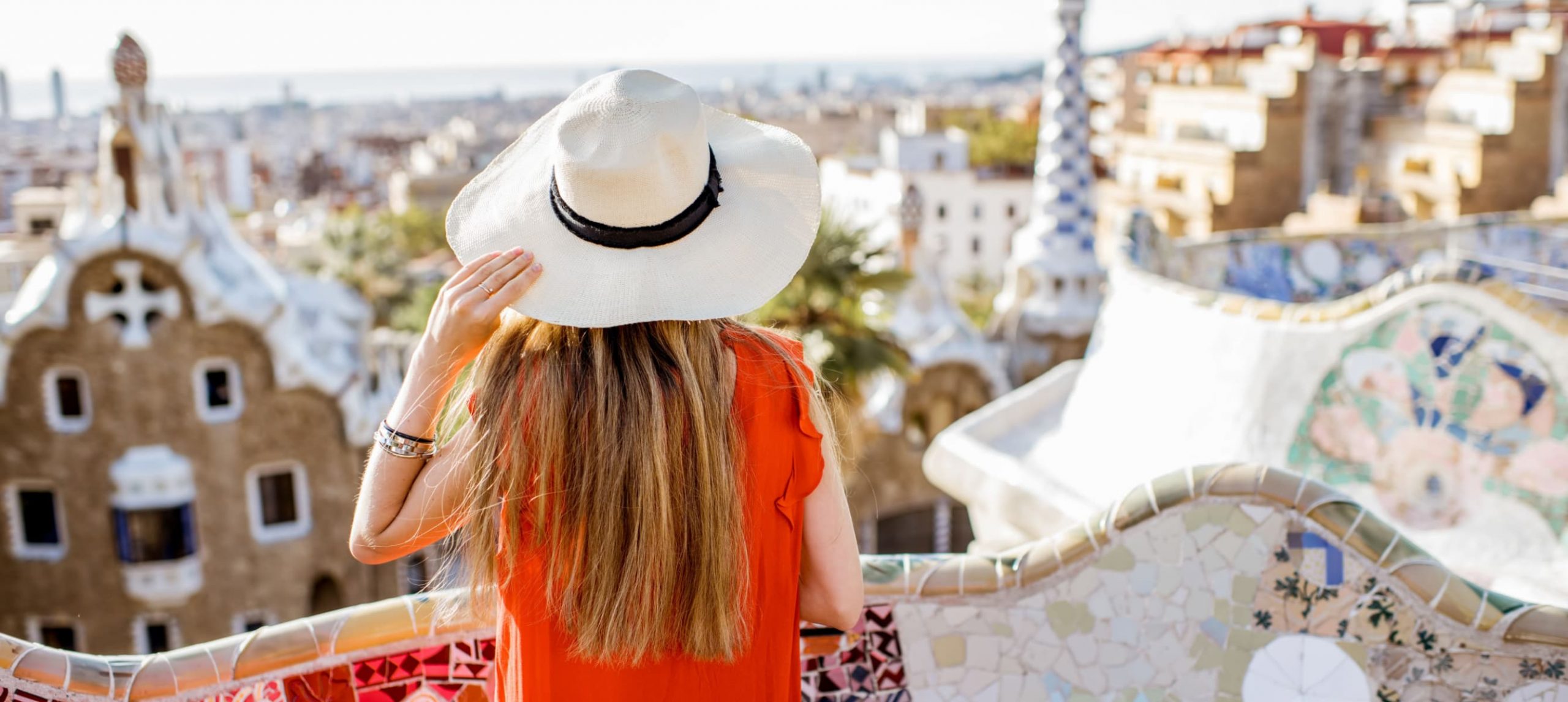
Barcelona, the vibrant capital of Catalonia, is a destination renowned for its rich history, stunning architecture, and artistic flair.
At the heart of the city’s architectural tapestry lies the remarkable legacy of architect Antoni Gaudí.
Known for their unique style, Gaudí’s visionary creations are a visual feast for the eyes and have left an indelible mark on Barcelona.
Thanks to their contribution to the development of architecture, several of Gaudi’s creations have actually been declared UNESCO World Heritage Sites.
Exploring Gaudí’s works is an absolute must for those with a penchant for architecture, a love of art, or a curiosity for Barcelona’s cultural heritage.
Among his masterpieces, the awe-inspiring Sagrada Família, a monumental church that stands as his magnum opus, commands attention.
But Gaudí’s influence extends far beyond this iconic structure, with other notable works such as Casa Batlló and Park Güell beckoning visitors to discover their enchanting beauty.
Join us as we embark on a journey through Barcelona’s architectural treasures, exploring the top 10 Gaudí buildings in Barcelona that showcase his genius and creativity.
About Antoni Gaudí
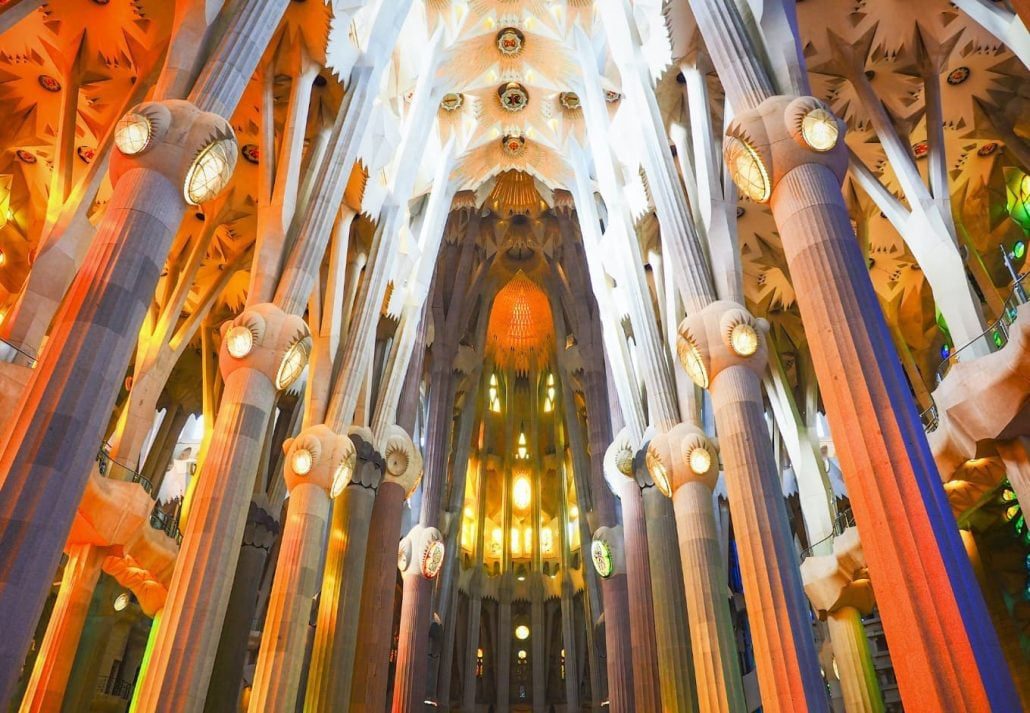
Who Was Antoni Gaudí?
Antoni Gaudí i Cornet (1852-1926) was a Spanish architect and one of the most prominent figures of the Catalan Modernism movement (Catalan Art Nouveau).
He was born in Reus, Catalonia, and later moved to Barcelona, where he spent the majority of his life and created his remarkable architectural legacy.
Gaudí’s unique and visionary approach to architecture earned him worldwide recognition as one of the greatest architects of his time.
Gaudí’s work was deeply influenced by nature, religion, and the cultural identity of Catalonia. He sought to create structures that seamlessly blended with their surroundings, employing organic forms, curvilinear shapes, and intricate detailing.
Perhaps the most famous and iconic of Gaudí’s buildings is the Sagrada Família in Barcelona.
This monumental basilica, which remains unfinished, showcases Gaudí’s innovative structural solutions, intricate ornamentation, and ability to imbue architecture with profound symbolism.
The church is a testament to his lifelong dedication, as he worked on its construction for over 40 years until his death.
Gaudí’s creativity extended beyond religious architecture. He designed numerous residential buildings, such as Casa Batlló and Casa Milà (La Pedrera), where he integrated functional elements with imaginative designs, resulting in structures that are both aesthetically striking and practical for everyday living.
His other notable works include Park Güell, a public park with fantastical elements and vibrant tile work, and Casa Vicens, one of his early works that showcase his architectural experimentation.
Gaudí died tragically after he was struck by a tram in Barcelona in 1926. He was initially mistaken for a beggar due to his humble appearance and was not immediately recognized.
By the time he received medical attention, his injuries were severe, and he passed away a few days later.
Why Are Gaudí’s Works So Famous?
Antoni Gaudí’s architectural style is a visual feast for the eyes.
Characterized by their organic forms, intricate detailing, and exuberance, Gaudi’s works defy conventional norms, exuding a sense of whimsy and imagination that is truly unparalleled.
Gaudí was also known for incorporating elements such as colorful mosaics, stained glass, wrought iron, and ceramics.
He also embraced organic forms, curved lines, and unique structural solutions, creating a distinct aesthetic that was ahead of its time.
Most buildings designed by Gaudí are heavily influenced by nature, and boast a sense of movement, making them visually captivating and unique.
The Catalan architect had meticulous attention to detail and his ability to combine various disciplines, including architecture, sculpture, stained glass, and furniture design was fascinating.
He collaborated with skilled artisans and craftsmen to bring his visionary ideas to life.
Gaudí’s works have become synonymous with Catalan Modernism, a cultural and artistic movement that emerged in Catalonia, Spain, during the late 19th and early 20th centuries.
His buildings are seen as the epitome of this movement, reflecting Catalonia’s cultural identity and a desire to break away from conventional architectural norms.
Seven properties built by the architect Antoni Gaudí in or near Barcelona were inscribed under the designation of “ Works of Antoni Gaudí ” by UNESCO as a World Heritage Site since 1984.
According to UNESCO these sites “testify to Gaudí’s exceptional creative contribution to the development of architecture and building technology in the late 19th and early 20th centuries.”
These seven buildings are Parque Güell; Palacio Güell; Casa Mila; Casa Vicens; Gaudí’s work on the Nativity façade and Crypt of La Sagrada Familia; Casa Batlló; Crypt in Colonia Güell.
Fun Facts About Antoni Gaudí
Antoni Gaudí knew that the Sagrada Familia wouldn’t be finished during his lifetime. He left detailed plans for the basilica’s most important parts to guide the building’s completion. After Gaudí’s death, the construction of La Sagrada Família progressed slowly and was halted by events like the Spanish Civil War. Gaudí is buried in the Sagrada Familia’s crypt. The architect was not an outstanding student, having difficulty obtaining a degree at the Barcelona Architecture School (BAS). When Gaudí was hit by a tram on his way to the Church of San Felipe Neri, in 1929, no one recognized him and he was mistaken for a beggar. Gaudí often collaborated with other artists and craftsmen, including sculptors, painters, and artisans, to bring his vision to life. Catalan painter Salvador Dalí was one of Gaudí’s biggest fans. Gaudí devoted most of his works to the Roman Catholic faith. Because of that, he was nicknamed “God’s Architect”.The 10 Best Gaudí Buildings in Barcelona, Spain
La Sagrada Família
 Photo Credit: Mistervlad/Shutterstock
Photo Credit: Mistervlad/ShutterstockListed as a UNESCO World Heritage Site since 2005 thanks to its historic and cultural significance,
La Sagrada Familia Basilica is not only the most popular attraction in Barcelona but the most visited monument in all of Spain.
La Sagrada Familia captivates visitors with its 18 magnificent spires and intricately carved façade that creates a visual representation of Christian beliefs.
The interior of La Sagrada Familia is equally beautiful. The basilica is sectioned into five naves, resembling a Latin cross with massive dimensions, and boasts inclined columns representing tree trunks branching out from the capitals into the vaults.
Gaudí also opted for shouting maximum light contrast with the stained glass windows on the interior of the basilica.
He added transparent glass on top to illuminate the vaults, which are embellished with ceramic tiles and flecks of shiny gold and had the light decrease as it moves down.
This gives the cathedral a transcendent atmosphere and a feeling of spiritual peace.
Considered one of the most beautiful buildings in the world, La Sagrada Familia is definitely a great starting point for exploring Gaudí’s works in Barcelona.
Make sure you read this ultimate guide to La Sagrada Familia for more information on the history of the basilica, ticket prices, tips for visiting, and more.
Address: Carrer Mallorca, 401 08013, Barcelona, Spain
Parc Güell

Parc Güell (Park Güell) is one of Gaudí’s most fascinating works. Listed as a World Heritage Site by UNESCO, this colorful park is known for its unique, picturesque shapes that’ll make you feel like you are in a Dr. Seuss storybook.
Nestled amidst a dense forest on top of Carmel Hill, Park Güell was commissioned by Eusebi Güell, a wealthy Catalan industrialist and Gaudí’s main patron, who wanted a residential garden city.
The park’s vibrant colors, organic shapes, and imaginative details have become hallmarks of Gaudí’s style. Several elements of Park Güell are decorated with multi-colored ceramic pieces, which provides the place with a remarkable and eye-popping aesthetic.
One of the most iconic features of Parc Güell is the serpentine bench that surrounds the central square, known as the “Plaza de la Naturaleza.”
The bench is adorned with multicolored tiles arranged in intricate mosaic patterns, creating a visually stunning and comfortable seating area for visitors to relax and enjoy the park’s ambiance.
Other notable structures within Parc Güell include the “Gaudí House Museum,” which was Gaudí’s former residence and now houses a collection of furniture and personal belongings that provide insight into his life and work.
Additionally, the park features various paths, staircases, and viaducts that showcase Gaudí’s mastery of blending architecture with the natural landscape.
Address: 08024 Barcelona, Spain
Recommended Read: The Ultimate Barcelona Travel Guide
Casa Batlló
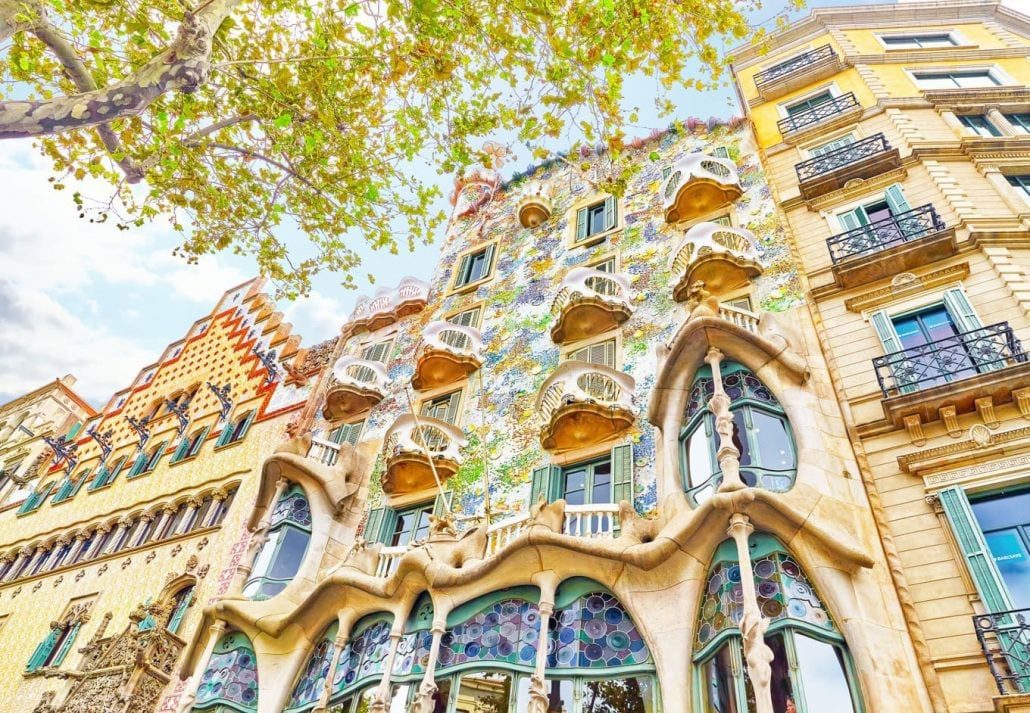 Photo Credit: V_E/Shutterstock
Photo Credit: V_E/ShutterstockCasa Batlló is a stunning residential building that’ll captivate with its colorful glass windows, sinuous shapes, and picturesque roof that resembles the scales of an aquatic creature.
Located on the leafy Passeig de Gràcia — one of Barcelona’s main avenues —, the house was originally built in 1877 by Emilio Sala Cortés (one of Gaudí’s architecture professors).
The building was redesigned by Gaudí in 1904 for wealthy textile industrialist Josep Batlló. Gaudí transformed the building into a masterpiece of Modernist architecture, both inside and out.
Taking inspiration from the marine world and the Mediterranean Sea, Gaudí designed a strikingly beautiful exterior adorned with a mosaic of colorful ceramic tiles in shades of blue, green, and gold, creating a visually captivating and dynamic facade.
The balconies of the building are designed to resemble the bones of a mythical dragon, with their intricate ironwork forming an organic and whimsical aesthetic.
Inside Casa Batlló, Gaudí’s creativity knows no bounds. The interiors flaunt a harmonious blend of design elements, including stained glass windows, intricate woodwork, and sculptural details.
The central lightwell, known as the “patio of lights,” is adorned with shimmering tiles that create a mesmerizing play of light and color as the sunlight filters through.
Address: Pg. de Gràcia, 43, 08007 Barcelona, Spain
Casa Mila (La Pedrera)
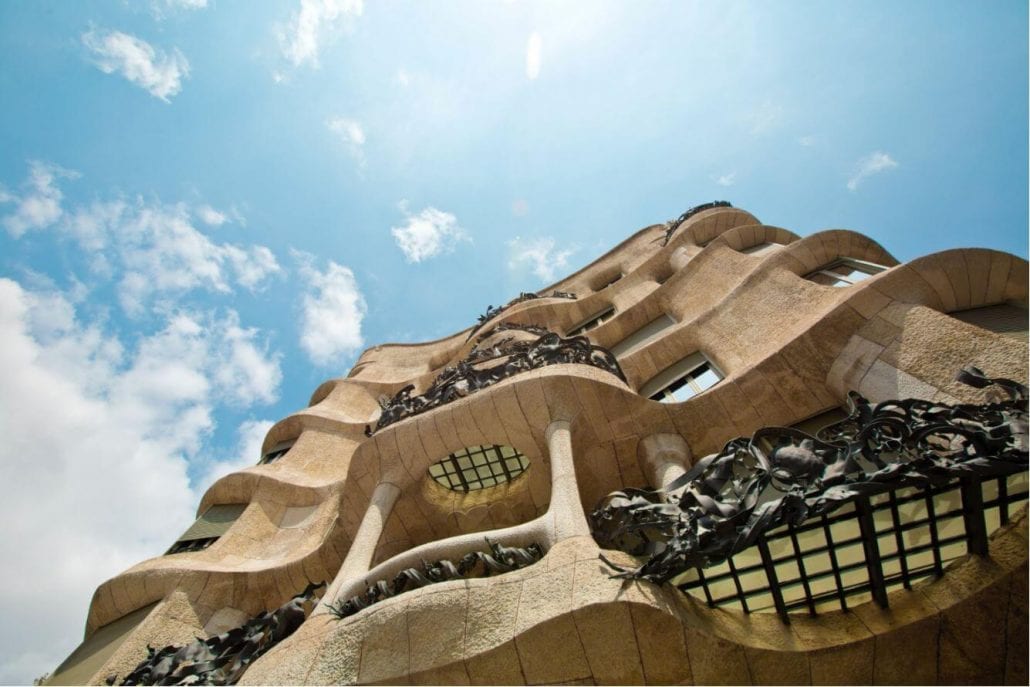
Casa Milà, also known as La Pedrera (“the stone quarry”), is the last private residence designed by Gaudí, and is often referred to as the architect’s most iconic work of civic architecture.
Situated in Passeig de Gràcia, the building was commissioned by affluent businessman Pere Milà as a private residence for his family.
Gaudí was given creative freedom to create a structure that reflected both the owner’s wealth and the progressive spirit of the era.
Casa Milà’s undulating stone facade appears to be sculpted and molded by the forces of nature.
The exterior is beautifully dotted with 32 balconies, and it’s made of three types of stone limestone from the Garraf, stone from Vilafranca del Penedès, and limestone from Ulldecona.
Inside, visitors can marvel at stunning tapestries by symbolist painter Aleix Clapés, and alluring ceilings decorated with inscriptions and even poems.
One of the most distinctive features of Casa Milà is its roof terrace. The undulating forms continue here, with chimneys and ventilation towers resembling surrealist sculptures.
Casa Milá’s rooftop is artfully adorned with intricate mosaic patterns created using broken ceramic tiles, known as trencadís, and offers showstopping panoramic views of Barcelona.
Address: Pg. de Gràcia, 92, 08008 Barcelona, Spain
Casa Vicens

Constructed between 1883 and 1885, Casa Vicens holds a significant place in the architectural career of Antoni Gaudí as it was his first major commission.
The building showcases Gaudí’s early architectural style and marks the beginning of his extraordinary career.
It was commissioned by Manuel Vicens i Montaner, a wealthy tile manufacturer, who wanted a summer residence that incorporated elements of Catalan and Mudéjar architecture.
Gaudí took inspiration from various sources, including Moorish and Oriental designs, resulting in a unique and eclectic architectural masterpiece.
Casa Vicens stands out for its vibrant colors, intricate detailing, and imaginative ornamentation.
The spectacular facade features a rich interplay of colorful ceramic tiles in shades of green, blue, and white, creating intricate floral and geometric patterns that add depth and visual interest to the exterior.
Gaudí also paid careful attention to details in the interior of the house, from the layout of the rooms to the choice of materials.
Inside, the house features a harmonious blend of different architectural elements, including arches, columns, and decorative motifs, all showcasing Gaudí’s creative genius.
Notable spaces within the house include the central courtyard, adorned with an ornate fountain and surrounded by lush vegetation, and the main living areas that showcase Gaudí’s use of color and natural light.
Address: Carrer de les Carolines, 20-26, 08012 Barcelona, Spain
Palau Güell (Palacio Güell)
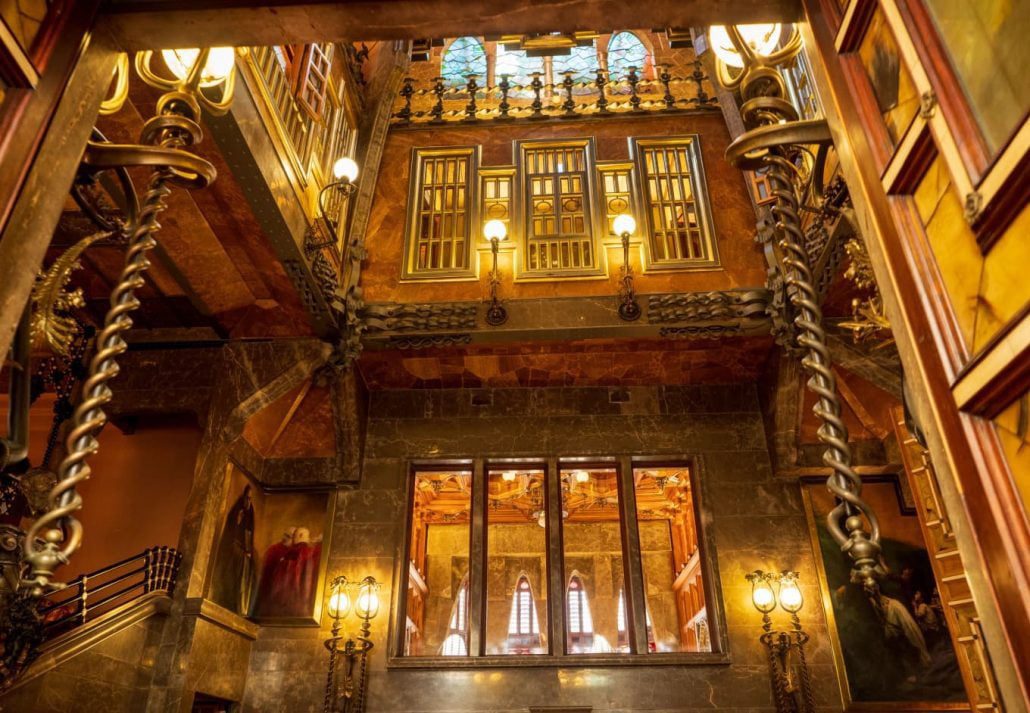 Photo Credit: silverfox999/Shutterstock
Photo Credit: silverfox999/ShutterstockPalau Güell, also known as Palacio Güell, is a remarkable mansion located in the El Raval neighborhood of Barcelona.
The palace was commissioned by Eusebi Güell, a wealthy Catalan industrialist and Gaudí’s main patron, as a residence for his family.
Constructed between 1886 and 1890, Palau Güell showcases Gaudí’s innovative approach to design and his ability to blend various architectural elements.
The exterior of the mansion features a harmonious combination of stone, ironwork, and stained glass.
The façade is adorned with ornamental motifs, including twisted columns, elaborate balconies, and unique chimneys, showcasing Gaudí’s meticulous attention to detail.
Inside the palace, Gaudí’s creativity shines through in every corner. The main hall, known as the Parabolic Hall, is a spectacular space that features a soaring ceiling adorned with intricate plasterwork and a skylight that allows natural light to flood the area.
The various rooms and living spaces of Palau Güell showcase a blend of architectural styles, including Gothic, Moorish, and Art Nouveau influences.
Palau Güell also boasts a rooftop terrace, which offers stunning views of Barcelona. The terrace is adorned with whimsical chimneys and ventilation towers, reminiscent of Gaudí’s later works, such as Casa Milà.
The rooftop also features a series of arches and decorative elements, displaying Gaudí’s ability to integrate functional structures with artistic flair.
Address: C/ Nou de la Rambla, 3-5, 08001 Barcelona, Spain
Colonia Güell
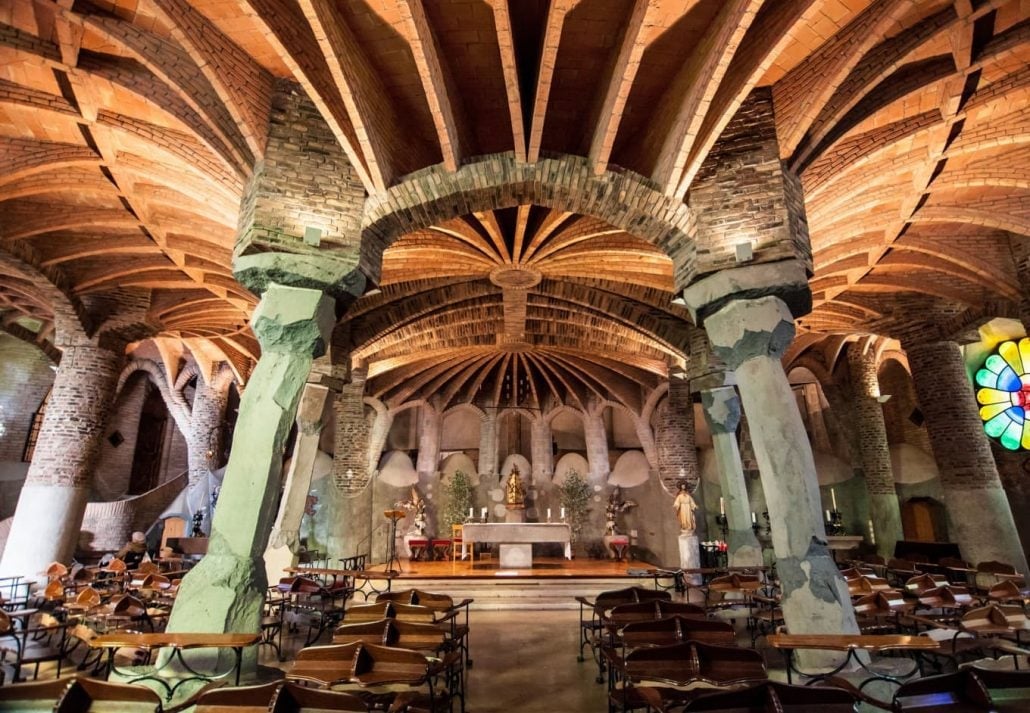 Photo Credit: Santi Rodriguez/Shutterstock
Photo Credit: Santi Rodriguez/ShutterstockLocated in Santa Coloma de Cervelló, just outside Barcelona, Colonia Güell was commissioned by Eusebi Güell as a residential complex for the workers of his textile factory.
Built between 1890 and 1918, Colonia Güell showcases Gaudí’s innovative approach to urban planning and his commitment to improving the living conditions of the working class.
Colonia Güell was conceived as a self-sufficient community, providing housing, amenities, and social services for the factory workers.
Gaudí’s design principles focused on creating a harmonious environment that integrated nature, architecture, and functionality.
Colonia Güell includes various architectural structures and spaces. Its centerpiece is the Crypt of Colonia Güell, which was intended to be a revolutionary church design. Due to financial constraints, only the crypt was completed.
Made of basaltic stone, bricks, and mosaics, the crypt features a unique combination of Gothic and organic elements, such as curved lines, intricate columns, and innovative structural solutions.
Apart from the crypt, Colonia Güell also features worker’s houses, a school, a cooperative store, a theater, and recreational spaces.
Gaudí paid attention to every aspect of the design, from the layout of the streets to the choice of materials, creating a cohesive and aesthetically pleasing environment.
Address: Carrer Claudi, Carrer Reixach, s/n, 08690 La Colònia Güell, Barcelona, Spain
Recommended Read: Amazing Day Trips From Barcelona
Casa Calvet
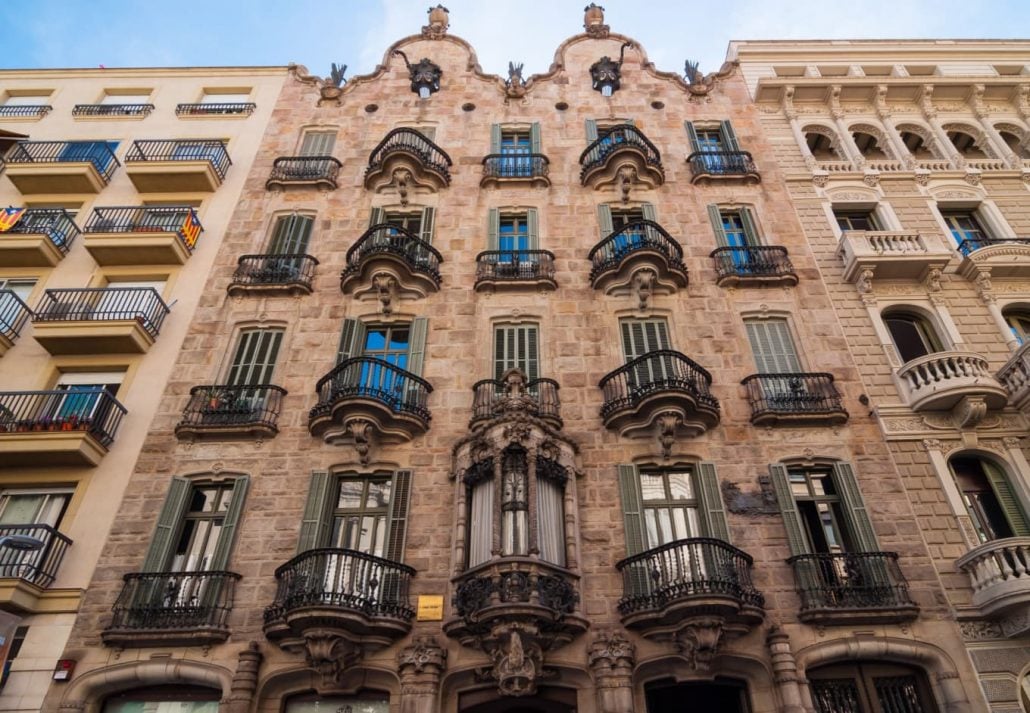 Photo Credit: Yury Dmitrienko/Shutterstock
Photo Credit: Yury Dmitrienko/ShutterstockCasa Calvet is an elegant residential building in the Eixample district of Barcelona.
It was built between 1898 and 1900 and is considered one of Gaudí’s more conventional works.
Casa Calvet was commissioned by textile manufacturer Pere Màrtir Calvet to serve as a residence for his family as well as an office space for his business.
Unlike Gaudí’s later creations, Casa Calvet follows a more traditional architectural style with influences from the Catalan Gothic Revival.
Casa Calvet’s stone façade showcases a restrained design compared to Gaudí’s later works. It features straight lines and a symmetrical layout, in contrast to the organic shapes and curvilinear forms for which the architect is renowned.
The façade is also adorned with ornamental elements, including wrought-iron balconies and intricate carvings, adding a touch of elegance to the building.
While Casa Calvet may not be as flamboyant as some of Gaudí’s later works, it still exhibits his signature style and mastery of architectural design.
The ground floor showcases Gaudí’s attention to detail and craftsmanship, with decorative elements such as ceramic tiles, woodwork, and stained glass windows.
The interior spaces feature a blend of different materials, including marble, wood, and iron, creating a rich and refined atmosphere.
Address: Carrer de Casp, 48, 08008 Barcelona, Spain
Teresian College

The College of the Teresians, or Collegi Teresiano del Passeig de Sant Gervasi, was designed and partially constructed by Antoni Gaudí.
The project was initiated in 1888 and 1889, and Gaudí was commissioned to take over the design and construction while the project was already underway.
Gaudí’s involvement in the College of the Teresians showcases his early works and highlights his transition from traditional architectural styles to the unique and innovative designs for which he later became famous.
The building represents a blend of different architectural influences, including Gothic Revival and Art Nouveau.
While Gaudí’s contributions to the College of the Teresians are not as extensive or well-known as his other major works, the building still bears his distinctive touches and design principles.
A noteworthy feature of the building is the inside corridor built with parabolic arches featuring elegant lines that, apart from being decorative, support the ceiling. The result is a combination of traditional and futurist forms.
Address: Carrer de Ganduxer, 85, Barcelona, Spain
Cascada Fountain, Parc de la Ciutadella
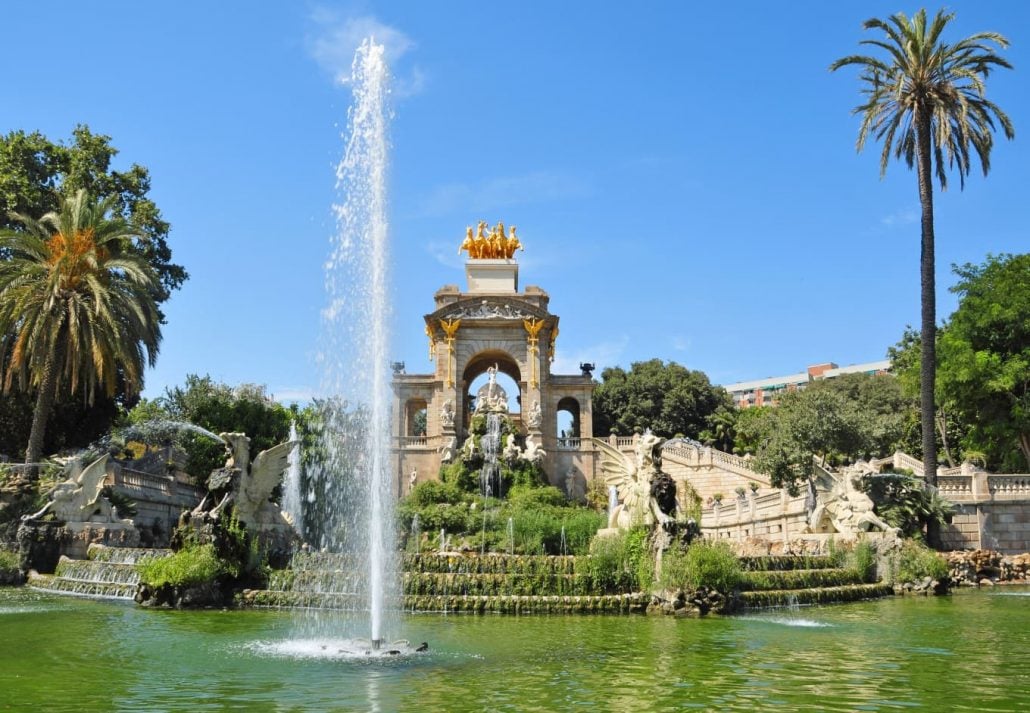
The Cascada Fountain is a magnificent architectural and artistic masterpiece designed by Josep Fontsére in collaboration with Antoni Gaudí, who was responsible for the ornamental details.
Beautifully nestled in Barcelona’s Parc de la Ciutadella, the fountain was built for the 1888 Universal Exposition held in Barcelona and was intended to be a grand centerpiece of the park.
Cascada Fountain’s architecture was inspired by the Trevi Fountain in Rome but with a unique Catalan touch and Gaudí’s artistic flair.
It’s a blend of different styles, including neoclassical, romantic, and Baroque influences. This alluring fountain also features a monumental and symmetrical design with a central waterfall surrounded by cascades, sculptures, and decorative elements.
At the top of the fountain, there is a large bronze sculpture representing the goddess Venus standing on a chariot, pulled by seahorses.
This sculpture is a stunning focal point and captures the attention of visitors with its grandeur and intricate details.
The base of the fountain is adorned with various sculptures and reliefs, including mythological creatures, sea creatures, and allegorical figures.
These sculptures were created by several renowned artists of the time, adding to the artistic richness of the fountain.
Address: Passeig de Picasso, 21, 08003 Barcelona, Spain
FAQ
Where are the 3 houses of Gaudi?
The Three Houses of Gaudi in Barcelona are Casa Batlló, Casa Mila, and Casa Vicens.
How many Gaudí buildings are there in Barcelona?
There are at least fourteen Gaudi structures in Barcelona alone.
What is the best Gaudí house to visit?
Ultimately, the “best” Gaudí house to visit depends on your personal interests and preferences. Both Casa Batlló and Casa Milà are remarkable examples of Gaudí’s creativity and are highly regarded by visitors.
What are the names of Antoni Gaudí three most famous works?
Sagrada Familia, Park Güell, and Casa Batlló are Gaudí’s most famous buildings.
What is one of Gaudí’s masterpieces in Barcelona?
Sagrada Familia is Gaudí’s most visited monument and most famous work.
Is Casa Mila worth the money?
Yes, Casa Mila is definitely worth visiting.
Are the Gaudí houses free?
There’s an entrance fee to go inside the houses, but you can take in the stunning exterior for free.
Is Sagrada Familia free?
There’s an entrance fee to go inside La Sagrada Familia.
Why is Park Guell so famous?
Park Güell is a testament to Antoni Gaudí’s artistic genius and visionary approach to architecture. Gaudí designed the park as a harmonious fusion of nature and art, creating a unique landscape filled with imaginative structures, vibrant colors, and intricate details.
CuddlyNest provides all accommodations to all travelers at the best price. Find unlimited travel inspiration on our blog and social media channels.
Here Are More Inspiring Readings For You:
Spain Travel Apps
Barcelona Legendary Attractions
Top Spanish Cities For 2021
La Tomatina Festival, Spain
Eating Tapas In Granada, Spain
Vegan Restaurants in Alicante, Spain
The Top 20 Spain Tourist Attractions
The Ultimate Guide to Lobos Island, Spain
Top Cultural Experiences In Spain
The Best Things to do in Barcelona with Kids
Barcelona Travel Guide
Free Things to do in Barcelona

 Lynk
Lynk 

























.jpg?trim=190,0,191,0&width=1200&height=800&crop=1200:800)
![The Largest Communities on Reddit [Infographic]](https://imgproxy.divecdn.com/vfTS-YsC_ZrqM6F4tAXJgV6qj3gCHSsf2dvHufDbrrQ/g:ce/rs:fit:770:435/Z3M6Ly9kaXZlc2l0ZS1zdG9yYWdlL2RpdmVpbWFnZS9sYXJnZXN0X3JlZGRpdF9jb21tdW5pdGllczIucG5n.webp)




